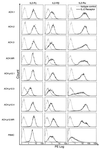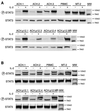Proliferation response to interleukin-2 and Jak/Stat activation of T cells immortalized by human T-cell lymphotropic virus type 1 is independent of open reading frame I expression
- PMID: 10516077
- PMCID: PMC113003
- DOI: 10.1128/JVI.73.11.9642-9649.1999
Proliferation response to interleukin-2 and Jak/Stat activation of T cells immortalized by human T-cell lymphotropic virus type 1 is independent of open reading frame I expression
Abstract
Human T-cell lymphotropic virus type 1 (HTLV-1), a complex retrovirus, encodes a hydrophobic 12-kD protein from pX open reading frame (ORF) I that localizes to cellular endomembranes and contains four minimal SH3 binding motifs (PXXP). We have demonstrated the importance of ORF I expression in the establishment of infection and hypothesize that p12(I) has a role in T-cell activation. In this study, we tested interleukin-2 (IL-2) receptor expression, IL-2-mediated proliferation, and Jak/Stat activation in T-cell lines immortalized with either wild-type or ORF I mutant clones of HTLV-1. All cell lines exhibited typical patterns of T-cell markers and maintained mutation fidelity. No significant differences between cell lines were observed in IL-2 receptor chain (alpha, beta, or gamma(c)) expression, in IL-2-mediated proliferation, or in IL-2-induced phosphorylated forms of Stat3, Stat5, Jak1, or Jak3. The expression of ORF I is more likely to play a role in early HTLV-1 infection, such as in the activation of quiescent T cells in vivo.
Figures





References
-
- Albrecht B, Ding W, Collins N, Wu X, Coggeshall K M, Green P L, Lairmore M D. Abstracts of Retrovirus Meeting 1999. Cold Spring Harbor, N.Y: Cold Spring Harbor Laboratory; 1999. Functional analysis of human T-cell lymphotropic virus type 1 p12 in vitro, abstr. 281; p. 281.
-
- Cereseto A, Berneman Z, Koralnik I, Vaughn J, Franchini G, Klotman M E. Differential expression of alternatively spliced pX mRNAs in HTLV-I-infected cell lines. Leukemia. 1997;11:866–870. - PubMed
-
- Cockerell G L, Rovnak J, Green P L, Chen I S Y. A deletion in the proximal untranslated pX region of human T-cell leukemia virus type II decreases viral replication but not infectivity in vivo. Blood. 1996;87:1030–1035. - PubMed
Publication types
MeSH terms
Substances
Grants and funding
LinkOut - more resources
Full Text Sources
Research Materials
Miscellaneous

